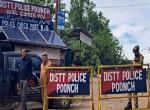The problem of the Left-wing Extremism (LWE) has been like a shifting pain that moved from West Bengal to Bihar in 1970s, and then to Andhra Pradesh in 1980s.
After nearly two decades, when there was pressure in Andhra Pradesh, the Naxals found suitable sanctuary in the central Indian areas comprising parts of Jharkhand, Chhattisgarh, Orissa, Maharashtra, Karnataka, Bihar and West Bengal. This constitutes the so-called “Red Corridor”, which they found conducive for insurgency and an ideal base to set up “Revolutionary Zones”. The movement of Maoists to tribal-dominated central India is in fact a perfect matching of the aggrieved and the “Robin Hoods”. Now there are reports that the Maoists are spreading to the northeast and the southwest of India. Why? Are they moving in search of new ‘safe zones’ because of military action in the central India? Or, are they spreading because they have found new breeding grounds for left-wing extremism? Or, is the shift to a ‘new theatre’ for some other reason?
It is known that the Indian Maoists have good network with several key militant groups of the northeast India that commenced roughly since the mid-1990s. In fact, with some groups like People’s Liberation Army of Manipur, the exact modalities of working – formal, semi-formal and informal – are spelled out through “memoranda of understanding”.1 The linkage ranges from getting arms, ammunitions, communication devices to training from the northeast militant groups like National Socialist Council of Nagaland (NSCN-IM), anti-talk faction of the United Liberation Front of Assam (ULFA) led by Paresh Barua, People’s Liberation Army (PLA), People’s Revolutionary Party of Kangleipak (Prepak), Revolutionary People’s Front (RPF), Kamtapur Liberation Organisation (KLO), Gorkha Liberation Tiger Force (GLTF), Gurkha Liberation Organisation (GLO), Adibasi National Liberation Army, Adivasi People’s Army (APA), and National Democratic Front of Bodoland (NDFB). Maoists, in turn, are said to be providing explosives (ammonium nitrate) and funds to the northeast groups. Chinese small arms find their way to the ‘Red Corridor’ mainly through these groups. It is through the northeast groups the Maoists have good access to militant groups of Myanmar. The mutual support between Naxals and northeast militant groups is not just restricted to material, but extends to moral aspects as well. While Naxals have strongly supported “people’s movements” of the northeast, the northeast militant groups have stood by “revolutionaries”. “Enemy’s enemy is a friend” is the guiding maxim in this case as well. ULFA leader Paresh Baruah once remarked, “The Indian colonial government is also viewed as an enemy by the Maoists. Our enemy is also the same and so there is an understanding with them.”2
But, what is more disconcerting is attempts being made by the Maoists to push the boundaries of the ‘Red Corridor’ and set up support bases in upper Assam and some of the tribal areas in the hilly interiors. The presence of Maoists is felt in pockets of Tinsukia, Dibrugarh, Lakhimpur, Dhemaji, Sivasagar, Golaghat and Karbi Anglong districts of Assam and Lohit district of Arunachal Pradesh (adjoining Tinsukia). The hub of Maoists activities is said to be in Sadiya area, situated in Assam-Arunachal Pradesh border. Governments of Assam and India have recently admitted to this.3 How deep is the penetration? This is where the ULFA chief Paresh Barua went partly wrong when he observed: “We have a definite strategy and we do not think Maoism will be able to strike deep roots in Assam”. 4 Maoists have clear-cut objective: capture of power, as against ULFA’s secession from India. The northeast India has now become a new “strategic area” by the Maoists. To Maoists,
The “strategic areas” are hilly regions with dense forest cover, have sufficient economic resources, a vast population, and a vast forest area spreading over thousands of square kilometers. In such areas the enemy is weak, and these areas are very favourable for the manoeuvers of the people’s army. In these strategic areas we can defeat the enemy completely by fulfilling the tasks of building and consolidating a strong proletarian party and a strong people’s army; procuring the people’s support and economic resources, while developing the guerrilla war aiming at the building of liberated/base areas in these areas.5
Therefore, apart from military utility of training, arms procurement and sanctuary, the Maoists also found parts of the northeast of India as a new zone of “revolution” to establish what they call as “base areas”. In this regard, two major causes are being exploited: deprivation among the tea workers of Assam and anti-dam sentiments in Arunachal Pradesh. Since there is political vacuum in both cases, Maoists are more than willing to fill them. Interestingly, adivasis in tea gardens are descendants of migrants from present-day Jharkhand, Bihar, Odisha, Chhatisgarh and Madhya Pradesh from the days of the British times. The Maoists have already set up local committees in these areas. From there it will become easy for them to link up to southern parts of Bhutan, where Nepali refugees are populated. Indian Maoists already have well-established links with the Bhutanese Maoists at both bilateral and global levels. They are members of umbrella organisations like Coordination Committee of Maoist Parties and Organisations of South Asia (CCOMPOSA), Revolutionary International Movement (RIM), World People’s Resistance Movement (WPRM) and International Communist Movement (ICM).
As it looks, Maoists are just making a foray in the region. It is, therefore, important to nip it in the bud. The idea of the government of Assam to form a special task force on the lines of Andhra Pradesh’s ‘Greyhounds’ and coordinated operation with neighbouring states like Arunachal Pradesh are fine. But what is more crucial is a comprehensive development approach. All Maoists want is a cause to exploit. And they spread their tentacles wherever grievances exist. Addressing the root causes, therefore, is important; breeding grounds should be busted. Basic development issues like water, healthcare, education and employment should be taken care of. Granting Scheduled Tribe status to the adivasis, carving out a separate Development Council, and reservations in local administration like Zilla Parishads are some of the measures that are worth considering at policy level and they need to be implemented without much time lag.
End-Notes:
- “PLA, Naxals signed MoU in 2008 for fighting govt: cops,” The Indian Express, 02 April 2012.
- “ULFA C-in-C Paresh Barua Confirms ULFA-Maoists links,” The Shillong Times, 03 February 2012.
- “Will take steps to curb Maoist menace: Tarun Gogoi,” Daily News and Analysis, 23 April 2012. “Maoists will be dealt with firmly: Chidambaram,” The Times of India, 12 May 2012.
- Ibid.
- Central Committee of CPI (Maoists), “Strategy and Tactics of Indian Revolution”, Chapter 7, p. 51, available at http://www.bannedthought.net/India/CPI-Maoist-Docs/Founding/StrategyTactics-pamphlet.pdf, accessed on 23 May 2012.
Published Date: 25th May 2012









Post new comment